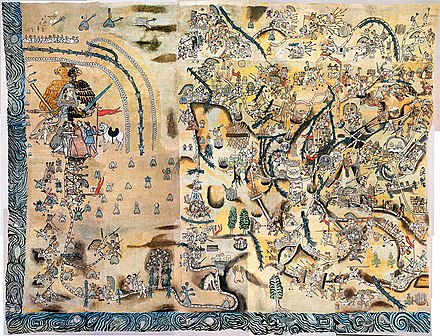Lienzo de Quauhquechollan
The Lienzo de Quauhquechollan ("Linen of Quauhquechollan") is a sheet from the 16th century painted by the Nahua . It is one of two surviving Nahua pictorial documents that tell the story of the Spanish conquest of Guatemala , and one of the first surviving maps of present-day Guatemala.
The Lienzo was probably painted in the Ciudad Vieja, in the Guatemalan Sacatepéquez department , from Nahua to Quauhquechollan, today's Huaquechula, Puebla in Mexico. These had allied themselves with the Spaniards and supported the conquistador Jorge de Alvarado, brother of Pedro de Alvarado on his campaign from 1527 to 1529. The allies from Quauhquechollan then settled in the highlands of Guatemala and painted the Lienzo, representing their participation in the Spanish Depicts conquest of Mexico and Guatemala. The original is currently in the Casa de Alfeñique museum in Puebla.
Manufacturing
The Lienzo was painted in the 1530s. It consists of 15 individually painted sheets that have been sewn together to form a large map. The parts are of different sizes and manufacturing methods, and some show that they have been reused. The entire Lienzo de Quauhquechollan measures 3.25 x 2.35 m. The Lienzo was implemented in a Central Mexican style and its indigenous art conventions to represent a mixture of Nahua and Spanish themes. The focus of the map lies within the boundaries of present-day Guatemala, especially around the Chimaltenango area and the colonial capital Santiago de los Caballeros de Guatemala . The Lienzo focuses on the role of the Quauhquechollan allies in the conquest, their journeys and the battles in which they participated. It was made by more than one artist, as shown by stylistic differences in the painting.
origin
The earliest mention of the Lienzo, under the name Lienzo de la Academia de Puebla ("Linen of the Puebla Academy"), comes from the last decade of the 19th century, when it is in the collection of the Academia de Pintura de Puebla ("Academy the painting of Puebla ”), but its origin was unknown. It contained various pieces of paper with texts attached to the pictures, written in the Latin alphabet, but which were poorly preserved.
content
The upper left corner of the Lienzo de Quauhquechollan shows a local glyph representing Quauhquechollan, combined with the Habsburg coat of arms. Below the Spanish conquistador Hernán Cortés is shown embracing a Quauhquecholtek nobility in greeting; both are accompanied by their entourage and the scene shows an exchange of gifts. The following scene shows Jorge de Alvarado at the head of a large army moving away from Quauhquechollan; the army itself is a mixture of Spaniards and Nahua. All Quauhquecholteks depicted are armed with Spanish swords, a privilege that was only granted to a few indigenous allies of the conquistadors. The route of the army on its march to Guatemala is described, among other things, through the stations Tehuantepec in Oaxaca and the Soconusco region in the lowlands of Chiapas ; both in what is now Mexico. In Guatemala, the army goes through Retalhuleu , Zapotitlán and Suchitepéquez and wages a series of battles there, even though Pedro de Alvarado had already conquered this region.
Individual evidence
- ↑ a b c d Restall and Asselbergs 2007, p. 94
- ↑ a b c d Asselbergs 2002, p. 4
- ↑ Restall and Asselbergs 2007, p. 94; Asselbergs 2002, p. 1
- ↑ Asselbergs 2002, p. 1
- ^ Universidad Francisco Marroquín 2009a
- ↑ Universidad Francisco Marroquín 2009b
- ↑ Asselbergs 2002, p. 2
- ↑ Asselbergs 2002, p. 4
- ↑ a b Asselbergs 2002, p. 6
- ↑ Asselbergs 2002, p. 5
- ↑ a b c d e Restall and Asselbergs 2007, p. 95
Web links
- Digital restoration of the Lienzo de Quauhquechollan of the Universidad Francisco Marroquín (English)
- La Conquista de Guatemala: Nuevas Perspectivas del Lienzo de Quauhquecholan en Puebla, México - Florine Asselbergs (Spanish)
